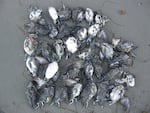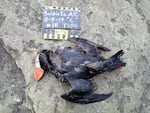Editor’s note: This story contains images of dead birds.

While Cannon Beach's Haystack Rock is the only place in the contiguous U.S. to see tufted puffins from the shore in the wild, bird lovers wanting a closer look can head down the highway to the Oregon Coast Aquarium.
Stephani Gordon
A new study from the University of Washington found that persistent heat waves in the marine environment linked to climate change are leading to the deaths of hundreds of thousands of seabirds several months later. The researchers also found that these mass die-offs of seabirds used to happen once a decade, but are now happening more frequently. That includes five consecutive years, from 2014 to 2019, when millions of seabirds washed up on beaches stretching from California to Alaska.
To make their findings, the scientists used nearly 30 years of surveys of bird carcasses spanning more than a thousand beaches along the West Coast, including Oregon. Most of the surveys were conducted by the Coastal Observation and Seabird Survey Team, a citizen science project which trains volunteers to collect data by scouring beaches to photograph and measure dead birds and marine debris deposited by the tides.
However, it was the absence of carcasses which would normally be seen after the breeding season that indicated something was off.
“So a lot of something can be bad, but the absence of something can also be bad. And in this particular case that’s because normally when we see carcasses floating ashore, they’re telling us that the system is actually in balance,” said Julia Parrish, a marine biologist at the University of Washington and co-author of the study which was published earlier this month.
Climate change is pushing this system out of balance as warming temperatures and El Niño events in the Pacific Ocean generate marine heat waves that are killing off tufted puffins, common murres and other iconic West Coast seabirds.
“What we know is that when the temperature goes up a degree or so above long-term normal and stays that way, we call that a marine heat wave,” Parrish said. “And when it stays that way, we’re going to get a big die-off of birds about one to six months after that starts.” Examinations of the dead, emaciated birds revealed signs of starvation.

In 2016, volunteers conducting beach surveys observed mass die-offs of seabirds such as Cassin's auklets following the large marine heat wave known as "the Blob" in the Northeast Pacific Ocean.
COASST
Some types of seabirds also appear to be more vulnerable to the impact of this marine warming than others. Birds such as tufted puffins, common murres and Cassian’s auklets, which belong to a family of deep-diving birds, experienced the highest rate of mortality.
Parrish and her team also observed that the mass die-offs used to happen once a decade, giving populations of seabirds time to bounce back, which could explain “the quiet winter” period when there were no carcasses washing ashore. But they now appear to be happening yearly, starting in 2014, when a massive marine heat wave known as “the Blob” hunkered down and spread across the Northeast Pacific Ocean.
“What we see the system doing now is just setting a lower bar if you will, for the number of seabirds that can be supported.” Parrish said.

University of Washington scientists found that tufted puffins and other deep-diving seabirds experienced a higher rate of mortality than other seabirds from marine heat waves. This photo shows the carcass of a tufted puffin that washed up on an Aleutian Island off the coast of Alaska in 2019 and was recorded in one of the surveys the University of Washington scientists analyzed to make their findings.
COASST
There are roughly 500 beaches that are being monitored by volunteers at COASST, a citizen science initiative that Parrish created 25 years ago. It is these watchful eyes that are helping to put into focus how climate change poses an existential threat to seabirds in ways that Parrish, or another marine biologist working alone, couldn’t do.
“That level of data we can only get by partnering with people … to figure out what’s the normal pattern, what are the changes from it, what’s creating those changes and what the future looks like, given those changes that are happening,” Parrish said.
That future, for at least some seabirds, darkens in the face of climate change and the existential threat it poses to their survival.
“I think we are facing a world with fewer seabirds, and that means by extension fewer other top predators as well, fewer marine mammals and quite possibly, fewer commercially important fish,” Parrish said.
Julia Parrish spoke to “Think Out Loud” host Dave Miller. Click play to listen to the full conversation:
